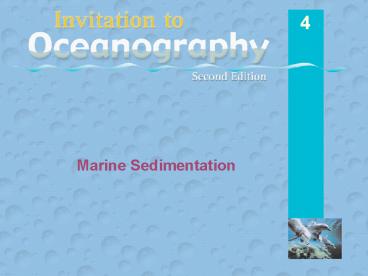Marine Sedimentation - PowerPoint PPT Presentation
1 / 17
Title:
Marine Sedimentation
Description:
Size classification divides sediment by grain size into gravel, sand and clay. ... in the deep sea include:, Bulk emplacement, Debris flows, Turbidity currents ... – PowerPoint PPT presentation
Number of Views:112
Avg rating:3.0/5.0
Title: Marine Sedimentation
1
Marine Sedimentation
2
Classification of marine sediments can be based
upon size or origin.
4-1
Sediment in the Sea
- Size classification divides sediment by grain
size into gravel, sand and clay. - Mud is a mixture of silt and clay.
- Origin classification divides sediment into five
categories Terrigenous sediments, Biogenic
sediments, Authigenic sediments, Volcanogenic
sediments and Cosmogenic sediments.
3
Factors that control sedimentation include
particle size and the turbulence of the
deposition environment.
4-1
Sediment in the Sea
- Terrigenous sediments strongly reflect their
source and are transported to the sea by wind,
rivers and glaciers. - Rate of erosion is important in determining
nature of sediments. - Average grain size reflects the energy of the
depositional environment. - Hjulstroms Diagram graphs the relationship
between particle size and energy for erosion,
transportation and deposition.
4
Based upon water depth, the ocean environment can
be divided into the shelf, which is shallow and
near a terrigenous source, and the deep ocean
basin, which is deep and far from a terrigenous
source.
4-2
Sedimentation in the Ocean
- Seaward, water becomes deeper and more distant
from a terrigenous source.
5
Shelf sedimentation is strongly controlled by
tides, waves and currents, but their influence
decreases with depth.
4-2
Sedimentation in the Ocean
- Shoreline turbulence prevents small particles
from settling and transports them seaward where
they are deposited in deeper water. - Particle size decreases seaward for recent
sediments. - Past fluctuations of sea level has stranded
coarse sediment (relict sediment) across the
shelf including most areas where only fine
sediments are deposited today.
6
(No Transcript)
7
Worldwide distribution of recent shelf sediments
by composition is strongly related to latitude
and climate.
4-2
Sedimentation in the Ocean
- Calcareous biogenic sediments dominate tropical
shelves. - River-supplied sands and muds dominate temperate
shelves. - Glacial till and ice-rafted sediments dominate
polar shelves.
8
(No Transcript)
9
Geologic controls of continental shelf
sedimentation must be considered in terms of a
time frame.
4-2
Sedimentation in the Ocean
- For a time frame up to 1000 years, waves,
currents and tides control sedimentation. - For a time frame up to 1,000,000 years, sea level
lowered by glaciation controlled sedimentation
and caused rivers to deposit their sediments at
the shelf edge and onto the upper continental
slope. - For a time frame up to 100,000,000 years, plate
tectonics has determined the type of margin that
developed and controlled sedimentation.
10
If influx of terrigenous sediment is low and the
water is warm, carbonate sediments will dominate.
4-2
Sedimentation in the Ocean
11
(No Transcript)
12
Deep-sea Sedimentation has two main sources for
sediment terrigenous material from the land and
biogenic and authigenic from the sea.
4-2
Sedimentation in the Ocean
- Major sedimentary processes in the deep sea
include, Bulk emplacement, Debris flows,
Turbidity currents - Major pelagic sediments in the ocean are red clay
and biogenic oozes. - Authigenic deposits are chemical and biochemical
precipitates that form on the sea floor and
include ferromanganese nodules and phosphorite.
13
(No Transcript)
14
(No Transcript)
15
The distribution of sediments in the deep ocean
varies greatly, but is strongly controlled by the
compensation depth.
4-2
Sedimentation in the Ocean
- Surface Deposits are the sediments found exposed
on the sea floor. - Deep-sea stratigraphy refers to the broad-scale
layering of the sediments of the sea floor. It
strongly reflects the sediment types deposited as
the sea floor
16
(No Transcript)
17
(No Transcript)































